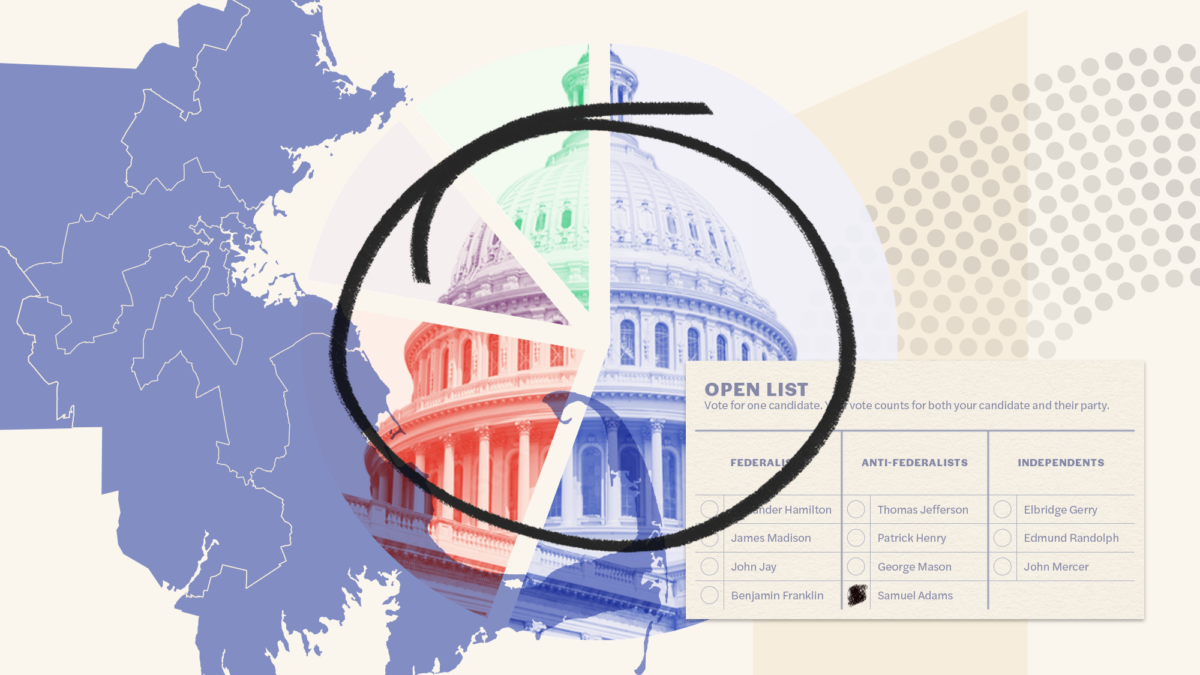How electoral reform happens
- September 12, 2023

Stable, consolidated democracies are defined, in large part, by the durability of their formal institutions. Citizens, elected officials, and political parties engage in politics expecting democratic rules and procedures to operate in a consistent and fair way.
However, democratic stability also requires adaptation: As democratic values change and expand, institutions may also need to change to ensure better democratic outcomes. Public discontent often brings about political demands to reform “the system” in some way or another. In the past few years, Americans have exhibited deepening distrust of institutions and more cynicism toward democracy; discontent has been on the rise. Citizens feel that government cannot solve big problems, and their appetite for change — ranging from small-bore reforms to upending the system entirely — has, in turn, been growing.
Practically speaking, narrow procedural changes are easier to achieve than deep structural reforms that reconfigure institutions in a fundamental way. The reform community has devoted time, energy, and organizational resources to incremental measures such as ranked-choice voting (where voters rank candidates in order of preference on a ballot, rather than just selecting one) and top-two primaries (where candidates from all parties run in a primary, and the top two advance to a general election). These have the potential to reduce the number of extremist candidates or to give voters more choices in elections. However, significant structural change — the kind that completely reconfigures how we allocate congressional seats or how many parties compete in elections — is rarely on the table.
Our legislative winner-take-all system is one of the most straightforward aspects of American democracy. Voters are presented with a list of candidates and select the candidate they like best; the candidate with the most votes wins. But most advanced democracies use some variant of proportional representation (PR). Under proportional systems, multiple candidates are elected in each district, and the distribution of seats in the legislature is roughly proportional to the votes received by each party. Most PR systems have more than two competitive parties, and these parties work together in coalitions to govern once elected to office.
American voters are fed up with the polarization in our two-party system and have demanded third parties or a fairer distribution of seats in the House of Representatives. Electoral system reform is a potential way to address these demands. While structural change is an ambitious goal to pursue, other democracies have successfully implemented major electoral reforms. Their experience shows how the public can be mobilized to care about the electoral system, and how reform-minded leaders can bring electoral reform to the national agenda.
In the 1990s, New Zealand, Italy, and Japan all changed from either winner-take-all or proportional representation to systems combining elements of both. These mixed-member systems change how legislative seats are allocated, with some seats reserved for candidates elected through single-member districts and other seats elected proportionally through party lists. Mixed-member majoritarian systems reserve more seats for single-member districts, while mixed-member proportional systems privilege seats elected proportionally. Because all three countries have parliamentary systems, changing how seats are allocated in the legislature also impacts government formation and the executive branch. All the reforms were designed to affect the party system in some way, particularly by influencing the number of competitive parties. While these three countries have different histories and cultures, their experiences can help us better understand the politics of electoral system reform.
First, the specifics of the reforms varied. New Zealand had a unicameral parliament with single-member-district plurality elections (a winner-take-all variant like ours), and its politics were dominated by two major parties (also like ours). After an initial referendum in 1992, in which voters signaled that they wanted to do away with single-member districts, New Zealanders voted the following year to adopt a new mixed-member proportional system. This system retained single-member-district plurality seats but also reserved a number of seats in parliament to be elected from party lists. Italy and Japan, on the other hand, moved from proportional representation to mixed-member majoritarian systems. In 1993, Italians were asked via popular referendum whether they wished to abandon PR for the upper house of parliament. After a majority voted yes, a new electoral law created a mixed-member majoritarian system that combined features of single-member districts with proportional representation for both chambers. In 1994, the Japanese government moved to a mixed-member majoritarian system combining single-member districts (for the majority of seats) with regional seats allocated proportionally.
There is no pattern to the problems these countries faced or the reforms they adopted: Italy had too much fragmentation among multiple parties, while Japan’s party competition nonetheless resulted in single-party dominance. However, one thing all three countries shared prior to their reforms was that the political status quo had lost legitimacy. Voters were fed up with what they considered to be dysfunctional political establishments. Italy had high-profile corruption scandals among politicians and volatility as successive governments collapsed, while Japanese legislators were seen as over-reliant on pork and patronage. In New Zealand, voters were sick of both parties, which they felt delivered unpopular policies, particularly related to economic liberalization. The possibility for electoral system reform therefore opens when a current system is, in Matthew Shugart’s terms, too “extreme,” and fails to capture majority preferences.
However, showing voters that problematic political outcomes are tied to the electoral system is a significant challenge. Academics have long noticed a relationship between electoral rules and the number of parties in a democracy; take, for example, “Duverger’s law,” the French political scientist Maurice Duverger’s observation that winner-take-all systems tend to lead to two-party politics. But in most democracies, voters are not all that concerned about the way institutions affect parties.
What was different in these three countries was that some of the most significant political problems were seen as directly tied to the electoral system. In New Zealand, more and more voters were opting for third-party candidates, but third parties could not translate their share of the popular vote (which was sometimes as high as 20 percent) into legislative seats. Further, there were two instances of “wrong winner” elections, in which the party receiving fewer votes at the national level nonetheless won a majority of seats in parliament. (This has also happened in the United States: In 2012, Republicans retained a 33-seat majority in the House despite Democrats receiving over 1 million more votes, and in the presidential elections of 2000 and 2016, Republican candidates received fewer votes but won the White House.) These problems were related to a version of a winner-take-all system. In Japan, candidates ran in multimember districts, but voters could choose only one candidate. This system, the single non-transferable vote, required politicians from the same party to campaign against one another and cultivate personalistic clienteles. Candidates had to distinguish themselves by offering pork and patronage, since they could not distinguish themselves by party labels alone. And in Italy, a version of proportional representation contributed to too much fragmentation of the party system, leaving voters little way to hold politicians accountable.
In adopting features of both single-member plurality and proportional representation, all three countries avoided a more significant reconfiguration of their electoral rules. Electoral system design is not just a science, but an art; there exists a spectrum of winner-take-all and proportionality. While proportional representation is associated with benefits that include more parties (and therefore more effective representation) and higher rates of participation, technical aspects of how PR is implemented — including the size of the districts and the threshold for parties to win seats — affect the number of parties and therefore the way governments form. These considerations are important as the reform community considers not only whether or not to reform the American electoral system, but how.
The scholar Alan Renwick argues that reforms often rely on “elite-mass interaction,” whereby some elites take up the cause of political reform and mobilize a segment of the public in favor. In Italy, the politician Mario Segni eventually broke with the Christian Democratic Party over the issue of reform. He argued that Italy needed to change from proportional representation and instead establish two parties. Segni led an organization called the Committee for Electoral Reform, which in the early 1990s began a campaign to put electoral reform to voters via referendum. In a 1993 referendum, 83 percent of voters chose to abandon the existing system. Italian legislators then adopted a mixed system with more plurality seats (elected through single-member districts) than proportional ones.
Similarly, New Zealand’s electoral reform was facilitated by Geoffrey Palmer, a Labour Party politician and law professor. He had published a book in 1979 (Unbridled Power?) that critiqued the electoral system, and he secured a commitment from the Labour Party to explore the issue. When the party came to power in 1984, with Palmer as deputy prime minister, the government appointed a Royal Commission to investigate electoral reform. The Royal Commission issued its report, “Towards a Better Democracy,” in 1986; it explicitly advocated a mixed-member proportional system. A grassroots movement called the Electoral Reform Coalition then took up the cause. In 1992, voters were asked in a national referendum if they wanted to keep winner-take-all or to change it; 85 percent voted for change. In a second referendum, in 1993, 54 percent of voters elected to move to a mixed-member proportional system. Japan’s reform was not decided by the public, but by party leaders themselves. Opposition parties and a faction within the dominant Liberal Democratic Party — the conservative party that had long held power in Japan’s single-party democracy — called for single-member districts in order to create a two-party system, to reduce incentives for corruption and excessive campaign spending, and to discourage personalistic campaigns in favor of party-centered ones. In 1994, the parties agreed to the mixed system combining single-member districts with proportional representation.
It is unsurprising that the impetus for electoral reform rarely comes from the political establishment that benefits from existing rules. However, it is also rare that the public, acting alone, will make electoral reform salient. Therefore, movements for reform require at least some political elites to spearhead calls for change. Those who take up the banner of reform often do so not in their own self-interest, but instead to create a fairer system for the long term.
Elites and dedicated reformers must then work together to advocate for electoral system change, but this requires agreement about the precise problem with the current electoral system. It also requires a coherence to the proposed reform. There is no single “best” electoral system, so reformers need to be specific about what democratic values are violated or undermined by the current system. Is it that one party is structurally advantaged or disadvantaged in a way that subverts voter preferences? Do they want more constraints on the number of parties, or do they instead want a system open to more parties? Should representation be based on where voters live, or instead tied to a national party? None of these outcomes are necessarily more or less legitimate, so making a case for change requires educating the public about which democratic values are at stake and why.
Conversations about electoral system reform in the United States are in their early stages. They tend to focus either on the deficiencies of winner-take-all or on the strengths of proportional representation. Acknowledging the tradeoffs of each system — for example, the simplicity and accountability associated with winner-take-all versus the fairness and representation associated with PR — will help reformers come to agreement on the precise democratic values they seek to foreground and expand.
However, an idea to change the electoral system remains merely academic without a politics of reform. A combination of elite leadership and some degree of public support is critical if electoral reform is to become part of the national political agenda. Seeding the idea that the electoral system is both a problem (in its current form) as well as a solution (in a new form) requires a campaign of education and mobilization. Those who want more parties, better representation, and a legislature that more accurately reflects Americans’ voting preferences — many of whom are already active in reform conversations — are a clear constituency for electoral reform. Many of them will need to be convinced that structural change is both possible and more impactful than narrower reforms that might be easier to secure in the short term. Reform leaders will also need to devise strategies for securing electoral system change, whether through state legislatures, state ballot initiatives, or congressional legislation. The experiences of New Zealand, Italy, and Japan provide a template, and show how reforming electoral systems can be a powerful way to address problems of parties, legitimacy, and democracy.
This piece originally appeared in For A Better Democracy: Proportional Representation, a symposium published by Democracy Journal in partnership with Protect Democracy and with support from Democracy Fund.
Related Content
It can happen here.
We can stop it.
Defeating authoritarianism is going to take all of us. Everyone and every institution has a role to play. Together, we can protect democracy.
Donate
Sign Up for Updates Sign Up for Updates
Explore Careers Explore Careers
How to Protect Democracy How to Protect Democracy



